

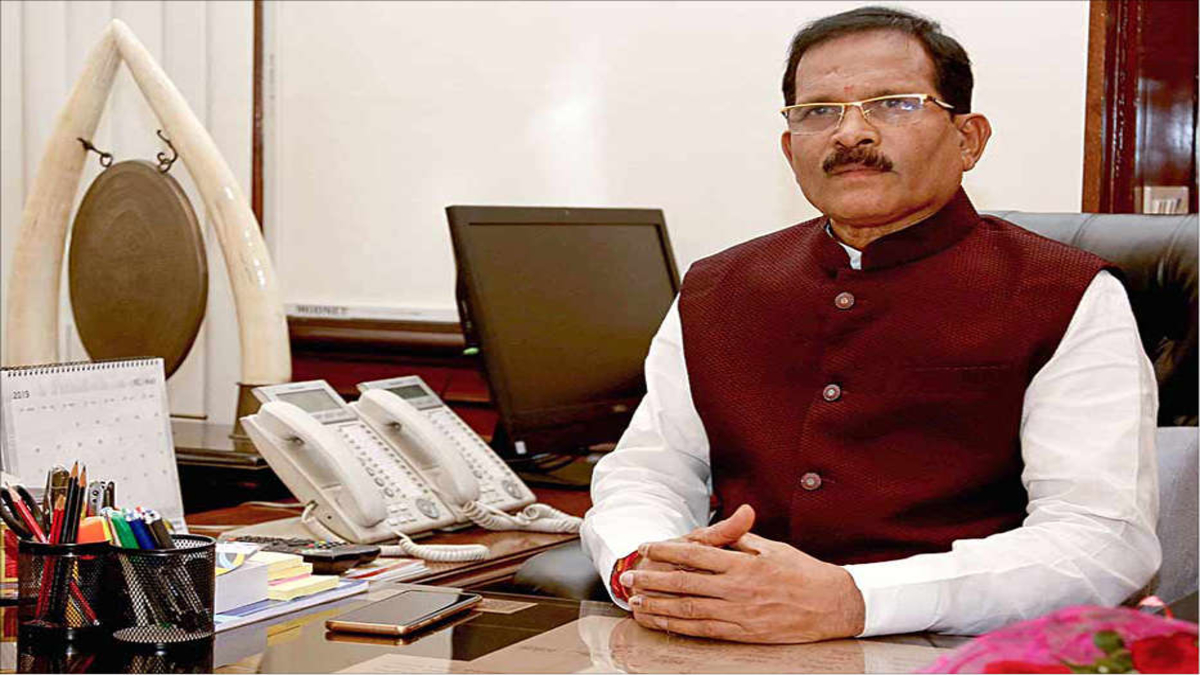
A draft ‘Defence Production & Export Promotion Policy’ (DPEPP) 2020 was placed in public domain by the Department of Defence Production, Ministry of Defence. This draft policy is positioned as Ministry of Defence’s overarching guiding document to provide a focused, structured and significant thrust to defence production capabilities of the country for self-reliance and exports. It envisions to make India amongst the top countries of the world in the defence sector, including Aerospace and Naval Shipbuilding sectors, from design to production, with active participation of public and private sector. This policy, inter alia, aims to create an environment that encourages R&D, rewards innovation, creates Indian Intellectual Property (IP) ownership and promotes a robust and self-reliant defence industry.
The new Defence Acquisition Procedure (DAP)-2020 has been released on 30th September, 2020. DAP-2020 is a product of extensive analysis, deliberations, interactions and focused formulations. It aims to further ‘self-reliance’ of the country in the defence sector by promoting indigenisation and bring ‘Ease of Doing Business’ with emphasis on Simplification, Delegation, Reduced Timelines and make the process as Industry friendly. This information was tabled in a written reply by Minister of Defence for State Shripad Naik to a question asked by Dr Banda Prakash in the Rajya Sabha.
MODERNISATION OF THE NAVAL FLEET
Indian Navy remains operationally ready and maintains combat ready platforms with additional forces in readiness at various bases/ports. Indian Navy is always ready to address any eventuality posed by the adversaries in its area of operations. It also diligently follows the Maintenance, Training, Operations and Deployment Cycle ensuring a high state of material as well as combat readiness encompassing all spectrums of maritime operations. Modernisation of Indian Navy is an ongoing process, and is undertaken in accordance with Long Term Integrated Perspective Plan which is reviewed from time to time. This information was tabled in a written reply by Minister of Defence for State Shripad Naik to a question asked by Dr Sabmit Patra in the Rajya Sabha.
PROPOSALS FOR INDIGENOUS DESIGNING AND MANUFACTURING OF DEFENCE SYSTEM
Defence Acquisition Procedure (DAP)-2020 envisages the basic tenets of ‘Aatmanirbhar Bharat Abhiyan’ and encourages indigenous designing and manufacturing of defence items. The proposals for indigenous design and manufacturing are considered under ‘Make’ Procedure of DAP-2020. The ‘Make’ Procedure aims to achieve the objective of self-reliance by involving greater participation of Indian industries including private sector through following mechanisms:
• Make-I (Government Funded): This involves design and development of equipment, systems, major platforms or upgrades thereof by the industry. Ministry provides financial support upto 70% of prototype development cost or maximum Rs. 250 crores per Development Agency (DA).
• Make-II (Industry Funded): This includes design & development and innovative solutions by Indian vendor, for which no Government funding is provided, but it has assurance of procurement on successful prototype development.
As on date, there are 4 ongoing projects under Make-I category. Further, 56 proposals have been accorded ‘Approval in Principal’ under Make-II category out of which 23 proposals have been accorded Acceptance of Necessity (AoN). In addition, Defence Research and Development Organisation (DRDO) has also undertaken 233 projects during the past three years since 2018. The projects include new defence equipment such as Cruise missile, Hypersonic missile, Anti-Ship missile, Extended Range Anti-Submarine Rocket, Mounted Gun System, Ammunitions, Electronic Warfare system, Radars, Torpedos, High Endurance Autonomous Underwater Vehicles, etc. AoN has been accorded for 45 DRDO developed systems during last 03 years since 2018 for induction into Services. Further, in order to promote indigenous design and development of defence equipment ‘Buy {Indian-IDDM (Indigenously Designed, Developed and Manufactured)}’ category under DAP is accorded top most priority for procurement of capital equipment. Ministry of Defence has notified a ‘Negative List’ of 101 identified items for which there would be an embargo on the import beyond the timeline indicated against them. This is a big step towards self-reliance in defence. This offers a great opportunity to the Indian defence industry to manufacture these items indigenously and develop capabilities to meet the requirements of the Armed Forces. This list includes some high technology weapon systems like artillery guns, assault rifles, corvettes, sonar systems, transport aircrafts, light combat helicopters (LCHs), radars, etc, to fulfil the needs of our defence services.
Further, an indigenization portal namely SRIJAN has also been launched in August, 2020 for Defence Public Sector Undertakings (DPSUs)/Ordnance Factory Board (OFB)/Services with an industry interface to provide development support to MSMEs/Startups/Industry for import substitution. As on date, 9,370 defence items, which were earlier imported, have been displayed on the portal. The Indian industry has shown interest for 1864 displayed items so far. The items displayed on the SRIJAN portal have well-structured description including specification, images, business volume etc. This information was tabled in a written reply by Minister of Defence for State Shripad Naik to a question asked by Sambhaji Chhatrapati in the Rajya Sabha.
MEASURES TAKEN TO PREVENT LOSS OF FISHERMEN LIVES FROM CYCLONES
Indian Coast Guard initiated the following pre-emptive and proactive measures to prevent loss of fishermen lives and to reduce impact from Cyclone Nivar and Burevi:
• ICG formations were put on high alert and high state of preparedness. Fisheries authorities, State authorities and local administration were warned for precautionary measures.
• Constant liaison had been made with the State administration, various departments and Indian Meteorological Department to ensure wide spread precautionary measures in the affected areas.
• Indian Coast Guard Remote Operating Centres (ROC) and Remote Operating Stations (ROS) passed security/safety messages in local languages on VHF (very high frequency) to all fishing boats to return to harbor or take shelter in nearest port.
• ISN (International Safety Net) was activated in Bay of Bengal and Arabian Sea by Maritime Rescue Co-ordination Centres (MRCCs) at Chennai and Mumbai respectively requesting transiting Merchant vessels to advise and warn fishermen to return to harbor/take shelter at nearest fishing harbor and render assistance, if required.
• Indian Coast Guard ships and aircraft were deployed in advance for issuance of advisories and warnings in vernacular languages to fishermen at sea for safe return to ports.
• A total of 23 and 33 Coast Guard Disaster Response Teams (DRTs) were kept standby during cyclones Nivar and Burevi respectively.
Due to the preventive and proactive efforts by multiple stakeholders during cyclone Nivar and Burevi, neither any incident/accident nor loss of any life at sea was reported. As per the Disaster Management Act, the National Disaster Management Authority (NDMA) and State Disaster Management Authority (SDMA) are mandated to deal with all types of disasters; natural or man-made. The Armed Forces are called upon to assist the civil administration when required. ICG form an important part of the Government’s response capacity and are immediate responders in all serious Coastal disaster situations. ICG has prepared Standard Operating Procedures for Disaster Management and the Standard Operating Procedures (SOPs) have been percolated to all formations and has initiated efforts for capacity building and training of ICG personnel. ICG units maintain close liaison and coordination with all State and District Authorities. This information was tabled in a written reply by Minister of Defence for State Shripad Naik to a question asked by Sanjay Seth and Rajeev Satav in the Rajya Sabha.
NEW SAINIK SCHOOLS IN PARTNERSHIP WITH NGOS/ PRIVATE SCHOOLS/STATES
Government is proposing to bring a new scheme for setting up Sainik Schools in the country in partnership with NGOs/Private Schools/States, etc. The endeavour is to provide schooling opportunities in “CBSE Plus” type of educational environment by involving desirous Government/Private Schools/NGOs to partner in establishing/aligning their system with Sainik Schools ethos, value system and national pride. It envisages enrolling existing/upcoming schools to be run on the lines of Sainik Schools curriculum. The schools are proposed to be affiliated to Sainik Schools Society. Detailed guidelines and requisite approvals are at an advance stage. Following are the details of Sainik Schools set up during last three days:
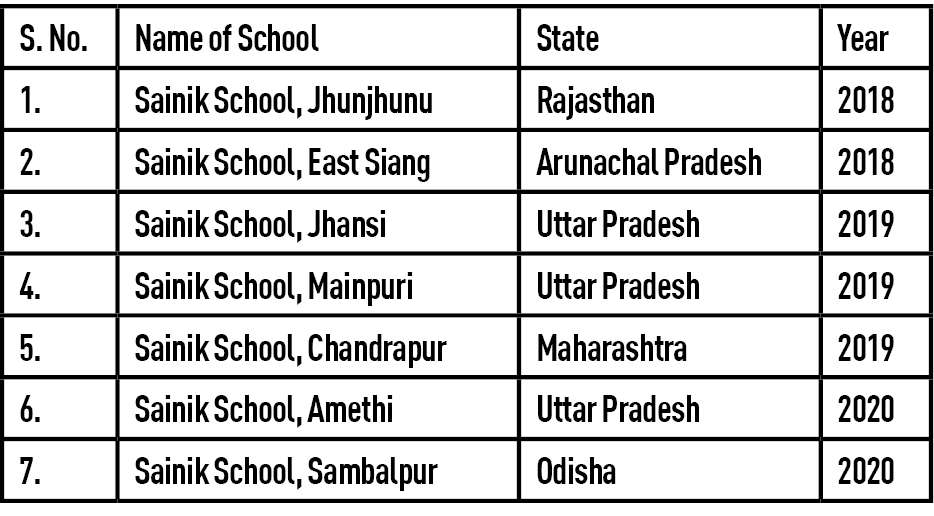
The details of the number of schools functioning at present in the country, state-wise, are:
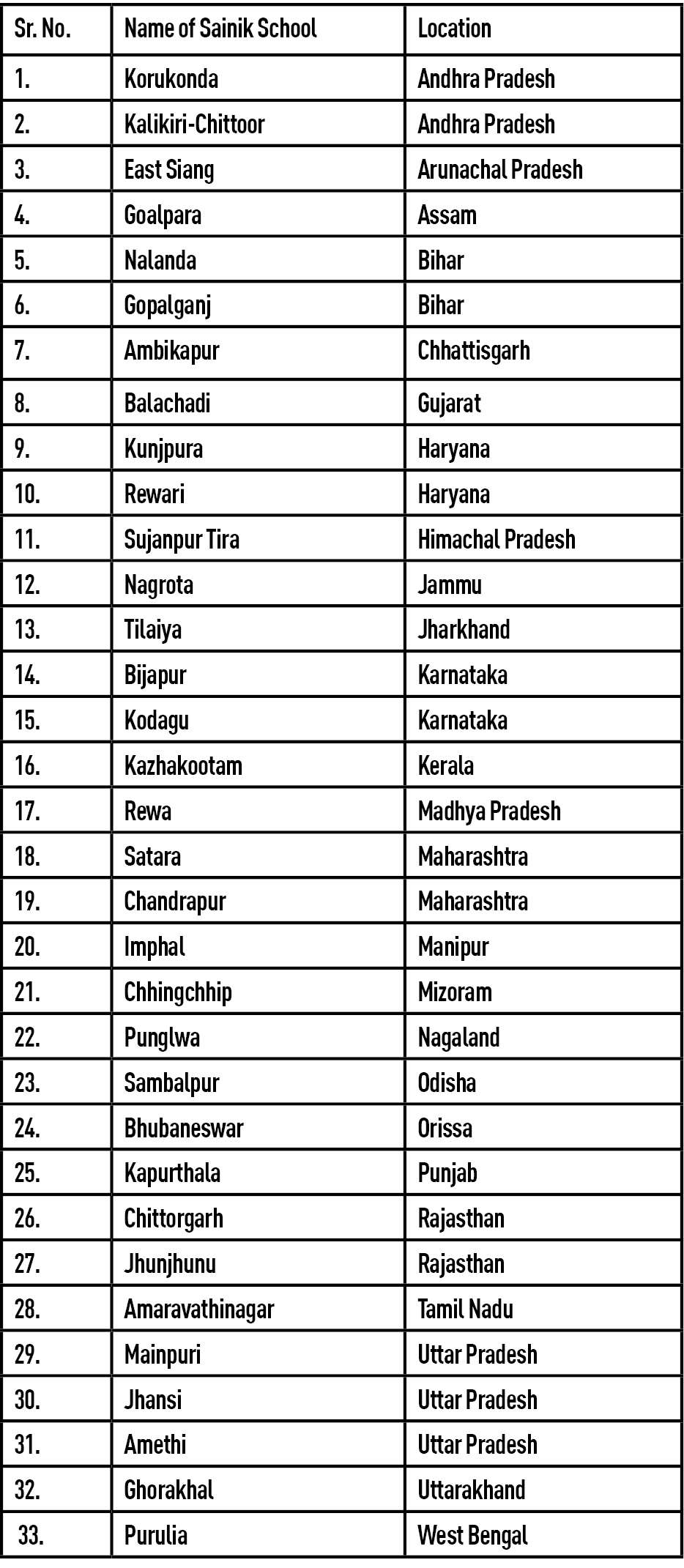
FEMALE EMPLOYEES IN DEFENCE SERVICES
The number of female employees in the armed forces is as under:* Excluding Medical and Dental personnel.
In addition to the provision of Permanent Commission to Women Officers in Judge Advocate General and Army Education Corps, the Government of India has recently announced grant of Permanent Commission to Women Officers in all other Arms/ Services in which they are eligible for commission. Further, the Government of India has sanctioned 1700 women in Military Police Corps in a phased manner. The Indian Air Force (IAF) undertakes various induction publicity measures to encourage youth including women to join IAF. Modules like direct contact programme, print and electronic media is extensively used to create awareness about IAF and educate students about various mode of entries. Approval to induct women in the Indian Navy was initially accorded in 1991 for a period of five years in the Education Branch, Logistics & Law Cadre of the Executive Branch. Since then, avenues for employment of Women Officers in the Navy have steadily expanded. Women induction commenced in various Branches/ Cadres/Specialisations viz. Air Traffic Controller (ATC) in 1993, Naval Constructor Cadre in 2001, Observers in 2008, Pilot and Naval Armament Inspectorate (NAI) Cadre in 2017, Sports and Musician Cadres and lateral induction into Provost Specialisation in 2019. The total avenues presently available to Women Officers are 11 in various Branches/Cadres/ Specialisations. Further, consequent to the Supreme Court’s Order dated 17th March, 2020, Women Officers in the Indian Navy are eligible for consideration for grant of Permanent Commission in ten out of eleven avenues open to them. Accordingly, in December 2020, 40 SSC Women Officers have been granted Permanent Commission. This is, in addition to the nine Women Officers who were granted Permanent Commission prior to the Supreme Court’s Order in the Cadres/Branches. This information was tabled in a written reply by Minister of Defence for State Shripad Naik to a question asked by Saroj Pandey in the Rajya Sabha.
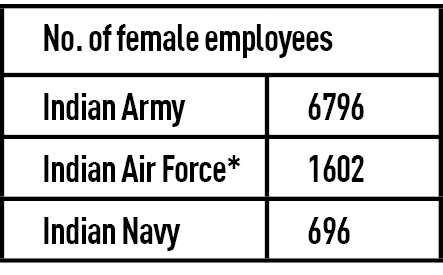
NEW INVENTIONS BY DRDO
During the past 3 years, 79 projects amounting to Rs.8201 Crores directly pertaining to development of new defence equipments i.e. Cruise Missile, Anti-Ship Missile, Surface-to-Air Missile, Air-to-Air Missile, Extended Range Anti-Submarine Rocket, Mounted Gun System, Ammunitions, Electronic Warfare System, Radars, Torpedoes, High Endurance Autonomous Underwater Vehicle, etc. have been undertaken. Some of the DRDO developed systems which are likely to be available to our defence personnel during 2021-23 are as follow:
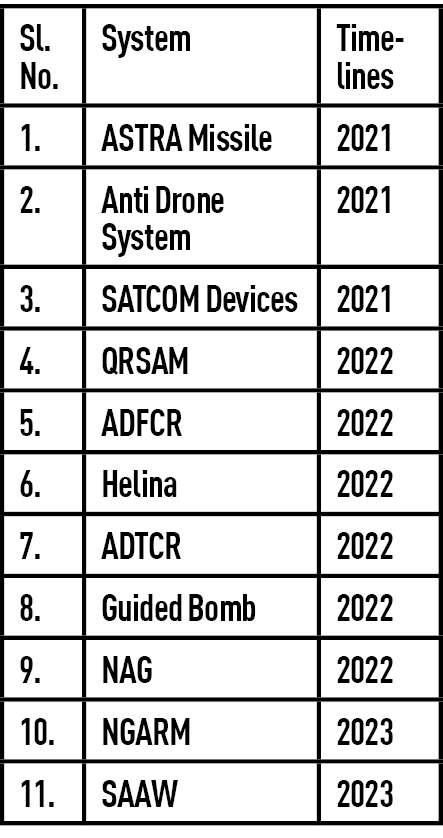
Many DRDO developed technologies such as Battle Field Surveillance Rader (BFSR), Joint Venture Protective Carbine (JVPC) Jammers, 5.56 mm Rifle, 40 mm Under Barrel Grenade Launcher (UBRL), Oleo Resin (OR) Grenade etc are being utilized by the State Police. Upgrades to some of the systems have been developed by DRDO. Details of the same are as follow:
• Arjun Mk-1A
• Akash-NG
• Light Combat Aircraft Mk-1A
• Medium Power Radar-Extended Range
• PINAKA- Extended Range, Guided
• Electronics & Communication System: Unified Mission Computer for SU-30 MKI aircraft, Internal EW System for MIG-29 Upgrade Aircraft, EW systems for Naval platforms.
This information was tabled in a written reply by Minister of Defence for State Shripad Naik to a question asked by Harnath Singh Yadav and Vijay Pal Singh Tomar in the Rajya Sabha.